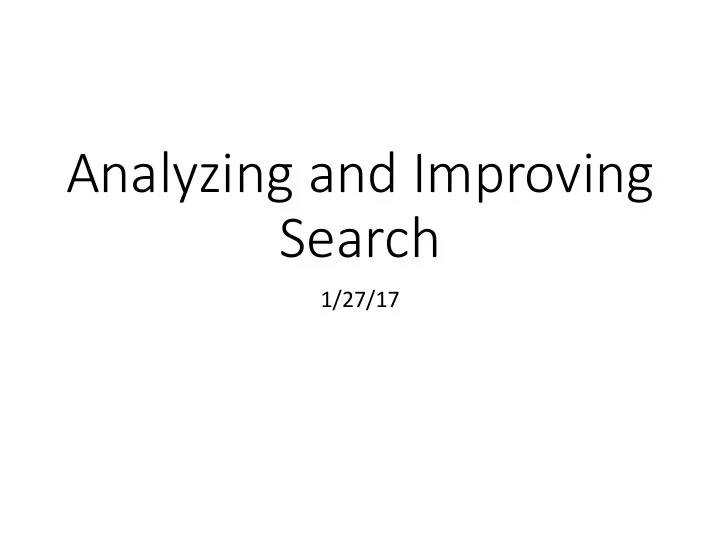

Analyzing and Improving Search 1/27/17
From Wednesday: Measuring Performance • Completeness : Is the search guaranteed to find a solution (if one exists)? • Optimality : Is the search guaranteed to find the lowest-cost solution (if it finds one)? • Time complexity : How long does it take to find a solution? • How many nodes are expanded? • Space complexity : How much memory is needed to perform the search? • How many nodes get stored in frontier + visited
Exercise: fill in the table A * BFS DFS UCS Greedy complete? optimal? time efficient? space efficient?
A* BFS DFS UCS Greedy only with complete? Y N Y Y cycle-checking optimal? N N Y Y N sort of no occasionally no often time efficient? yes!!! no no no no space efficient?
From Wednesday: Devising Heuristics • Must be admissible : never overestimate the cost to reach the goal. • Should strive for consistency : h(s) + c(s) non- decreasing along paths. • The higher the estimate (subject to admissibility), the better. Key idea: simplify the problem. • Traffic Jam: ignore some of the cars. • Path Finding: assume straight roads.
Exercise: devise a heuristic 8-puzzle: 8 2 • Actions: a tile orthogonally adjacent to the empty space 1 4 3 can slide into it. • Goal: arrange the tiles in 7 6 5 increasing order. 1 8 2 1 8 2 1 2 3 … 4 3 4 3 4 5 6 7 6 5 7 6 5 7 8 1 8 2 7 4 3 6 5
Why is A* complete and optimal? • Let C* be the cost of the optimal solution path. • A* will expand all nodes with c(s) + h(s) < C*. • A* will expand some nodes with c(s) + h(s) = C* until finding a goal node. • With an admissible heuristic, A* is optimal because it can’t miss a better path. • Given a positive step cost and a finite branching factor, A* is also complete.
Why is A* optimally efficient? • For any given admissible heuristic, no other optimal algorithm will expand fewer nodes. • Any algorithm that does NOT expand all nodes with c(s) + h(s) < C* runs the risk of missing the optimal solution. • Only possible difference could be in which nodes are expanded when c(s) + h(s) = C*.
Iterative Deepening • Inherits the completeness and shortest-path properties from BFS. • Requires only the memory complexity of DFS. Key idea: • Run a depth-limited DFS. • Increase the depth limit if goal not found.
IDA*; Branch and Bound • Use DFS, but with a bound on c(s) + h(s). • If bound < c(goal), the search will fail and we’ll have to increase the bound. • IDA* starts with a low bound and gradually increases it. • If bound > c(goal), we may find a sub-optimal solution • We can re-run with c(solution) - ε as the new bound • Branch and bound starts with a high bound and lowers it each time a solution is found. • We can alternate these two to narrow in on the right bound. • With reasonable bounds, these will explore an asymptotically similar number of nodes to A*, with a lower memory overhead.
Bidirectional Search • Also search from the goal(s) toward the start. • Requires a known, finite set of goals.
Island-driven search • Identify way-points (islands) that indicate progress toward the goal. • Search for a path to the next waypoint. • Not optimal unless you’re sure that the waypoint is on the optimal path. Goal
Exercise: trace A* Use the Manhattan distance heuristic. Start Goal 1 8 2 1 2 3 4 3 4 5 6 7 6 5 7 8
Recommend
More recommend